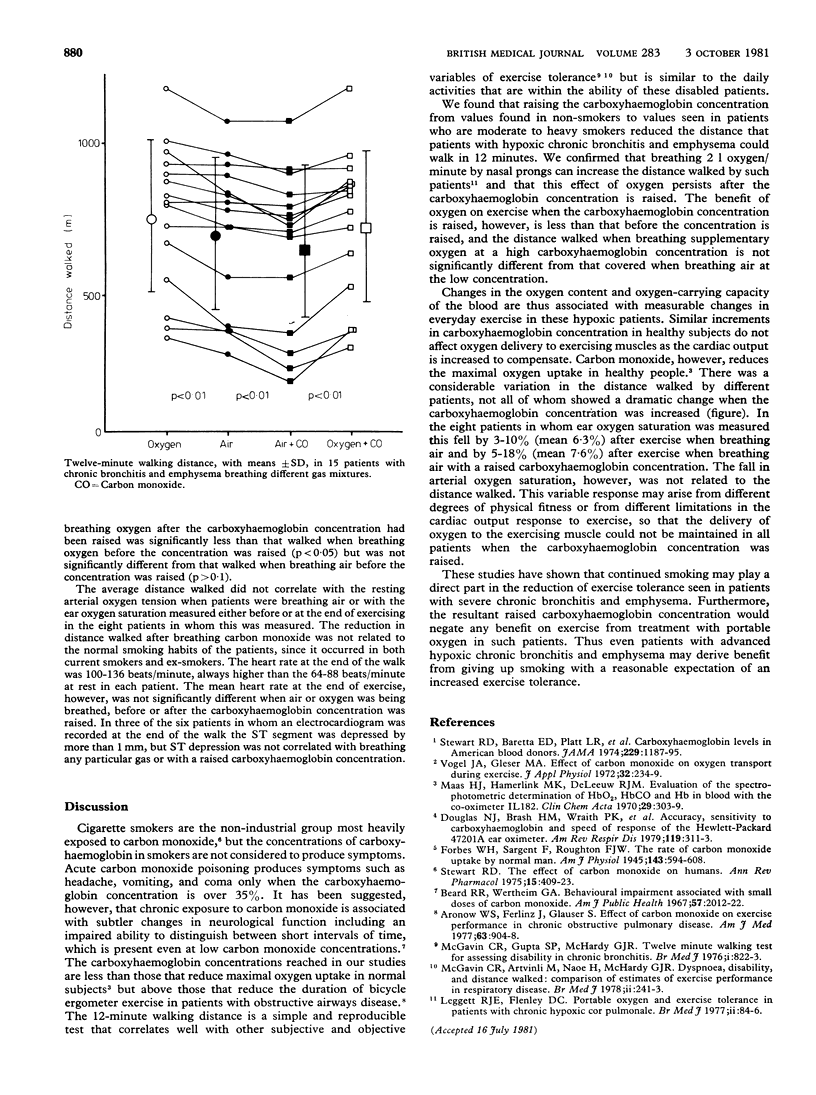Abstract
The effects of carbon monoxide on exercise tolerance as assessed by the distance walked in 12 minutes were studied in 15 patients with severe chronic bronchitis and emphysema (mean forced expiratory volume in one second 0.56 1, mean forced vital capacity 1.54 1). Each subject walked breathing air and oxygen before and after exposure to sufficient carbon monoxide to raise their venous carboxyhaemoglobin concentration by 9%. There was a significant reduction in the walking distance when the patients breathed air after exposure to carbon monoxide (p less than 0.01), and the significant increase in walking distance seen after exercise when breathing oxygen at 2 1/minute via nasal cannulae was abolished if carbon monoxide has previously been administered. Thus concentrations of carboxyhaemoglobin frequently found in bronchitic patients who smoke may reduce their tolerance of everyday exercise, possibly by interfering with the transport of oxygen to exercising muscles.
Full text
PDF


Selected References
These references are in PubMed. This may not be the complete list of references from this article.
- Aronow W. S., Ferlinz J., Glauser F. Effect of carbon monoxide on exercise performance in chronic obstructive pulmonary disease. Am J Med. 1977 Dec;63(6):904–908. doi: 10.1016/0002-9343(77)90544-7. [DOI] [PubMed] [Google Scholar]
- Beard R. R., Wertheim G. A. Behavioral impairment associated with small doses of carbon monoxide. Am J Public Health Nations Health. 1967 Nov;57(11):2012–2022. doi: 10.2105/ajph.57.11.2012. [DOI] [PMC free article] [PubMed] [Google Scholar]
- Douglas N. J., Brash H. M., Wraith P. K., Calverley P. M., Leggett R. J., McElderry L., Flenley D. C. Accuracy sensitivity to carboxyhemoglobin, and speed of response of the Hewlett-Packard 47201A ear oximeter. Am Rev Respir Dis. 1979 Feb;119(2):311–313. doi: 10.1164/arrd.1979.119.2.311. [DOI] [PubMed] [Google Scholar]
- McGavin C. R., Artvinli M., Naoe H., McHardy G. J. Dyspnoea, disability, and distance walked: comparison of estimates of exercise performance in respiratory disease. Br Med J. 1978 Jul 22;2(6132):241–243. doi: 10.1136/bmj.2.6132.241. [DOI] [PMC free article] [PubMed] [Google Scholar]
- McGavin C. R., Gupta S. P., McHardy G. J. Twelve-minute walking test for assessing disability in chronic bronchitis. Br Med J. 1976 Apr 3;1(6013):822–823. doi: 10.1136/bmj.1.6013.822. [DOI] [PMC free article] [PubMed] [Google Scholar]
- Stewart R. D., Baretta E. D., Platte L. R., Stewart E. B., Kalbfleisch J. H., Van Yserloo B., Rimm A. A. Carboxyhemoglobin levels in American blood donors. JAMA. 1974 Aug 26;229(9):1187–1195. [PubMed] [Google Scholar]
- Stewart R. D. The effect of carbon monoxide on humans. Annu Rev Pharmacol. 1975;15:409–423. doi: 10.1146/annurev.pa.15.040175.002205. [DOI] [PubMed] [Google Scholar]
- Vogel J. A., Gleser M. A. Effect of carbon monoxide on oxygen transport during exercise. J Appl Physiol. 1972 Feb;32(2):234–239. doi: 10.1152/jappl.1972.32.2.234. [DOI] [PubMed] [Google Scholar]


